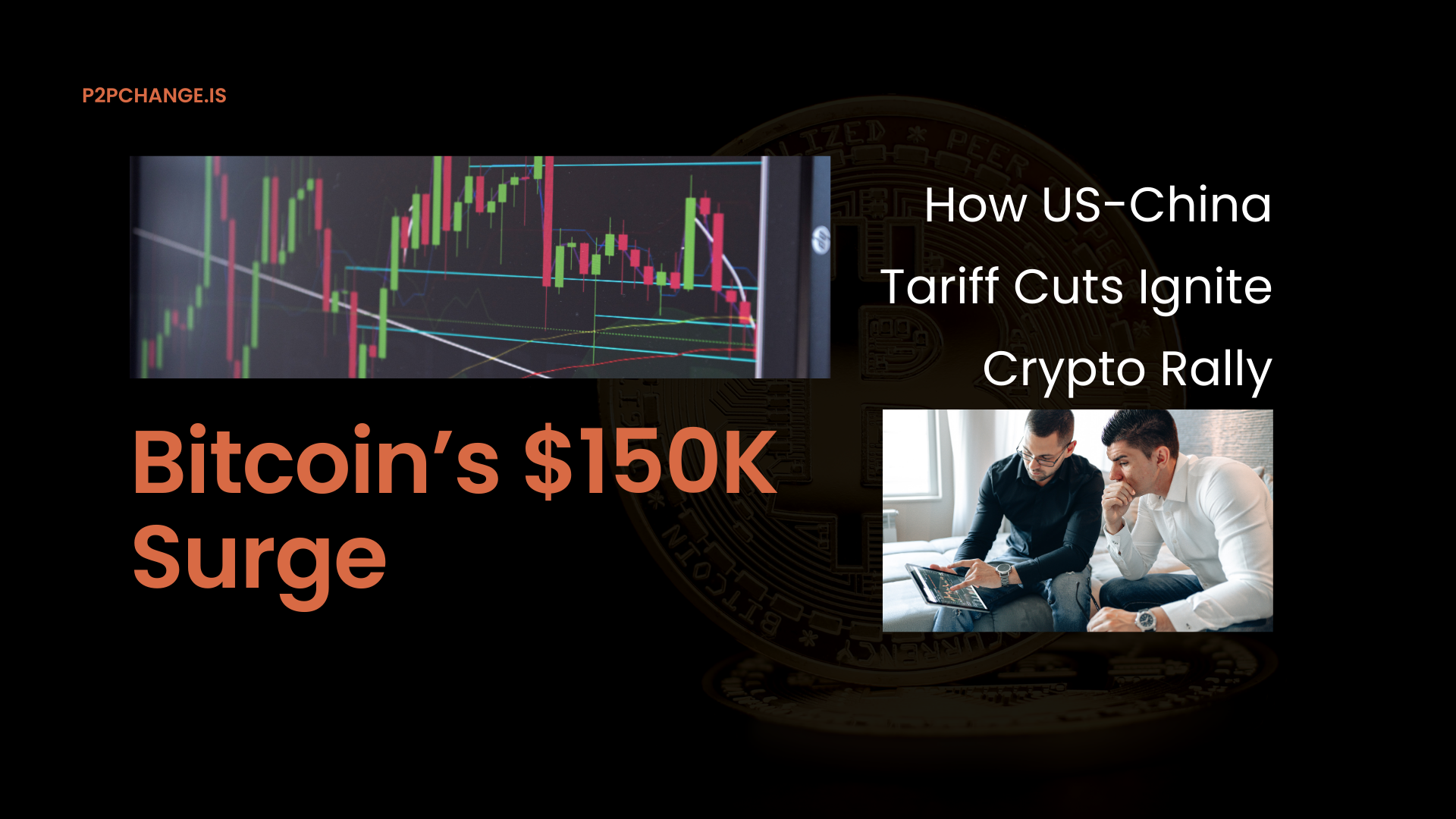
Introduction
Bitcoin (BTC) is surging toward $150,000, fueled by a landmark agreement between the U.S. and China to slash tariffs, sparking a risk-on sentiment boost for cryptocurrencies. The world’s largest cryptoasset has climbed 12% in the past week, with analysts attributing the rally to easing trade tensions, reduced economic uncertainty, and Bitcoin’s role as an inflation hedge. This article explores how geopolitical developments are driving BTC’s historic ascent and what investors should watch next.
The US-China Trade Deal: A Catalyst for Bitcoin
On May 15, 2025, the U.S. and China announced a mutual tariff reduction, cutting duties on $200 billion in goods. The agreement includes:
- U.S.: Lowering tariffs on Chinese imports from 145% to 30%.
- China: Reducing U.S. import taxes from 125% to 10%.
This move marked the first major trade détente in years, easing fears of a prolonged economic slowdown. Analysts at CoinDesk noted the deal could boost global GDP by 0.8%, while Bitcoin’s price reaction underscored its status as a macroeconomic barometer.
Why Tariffs Matter for Bitcoin:
- Risk-On Sentiment: Reduced trade wars mean investors shift from defensive assets (gold) to riskier plays like crypto.
- Inflation Hedge: Tariff cuts may slow price spikes from import costs, but Bitcoin’s scarcity remains a hedge against lingering inflation.
- Dollar Weakness: A stronger yuan and weaker U.S. dollar benefit BTC, priced in USD.
Technical Analysis: Bitcoin’s Path to $150K
BTC’s price action confirms a bullish breakout:
- Resistance Break: Surged above $125K resistance (key since 2023), triggering algorithmic buys.
- Support Levels: Holds above $118K, with the next target at $140K (psychological midpoint).
- Volume Surge: Trading volumes hit $30 billion daily—a 40% jump from April—indicating institutional inflows.
Analyst Take:
“The tariff deal acted as a catalyst, but Bitcoin’s rally is structural. With $150K now in sight, we could see a $200K test by year-end if macro stability holds,” said Omkar Godbole, CoinDesk Markets Editor.
Broader Market Implications
The tariff agreement’s ripple effects extend beyond Bitcoin:
- Equities Rise: Global stock indices (S&P 500, Nikkei) climbed 5%, mirroring crypto gains.
- Gold Pullback: Spot gold fell 3% to $3,200, as traders rotated into risk assets.
- Altcoin Surge: Ethereum (ETH) rose 8%, while stablecoins like USDC saw $5 billion inflows as traders rebalance portfolios.
Why Bitcoin Leads:
- Decentralized Nature: Unaffected by geopolitical posturing, Bitcoin’s protocol ensures no single entity controls its supply or value.
- Market Maturity: Institutions now view BTC as a core portfolio component, not just a speculative bet.
Risks and Challenges
While optimism dominates, risks linger:
- Regulatory Overreach: The SEC’s pending Bitcoin ETF approval remains a wildcard. A delay could cap gains.
- Volatility: BTC’s 15% weekly swings highlight its sensitivity to macro shifts.
- Tariff Rollbacks: The 90-day tariff reduction is temporary; tensions could resurface.
Analyst Warning:
“Bitcoin’s $150K target hinges on sustained trade optimism. If the U.S.-China deal unravels, BTC could retrace to $100K,” cautioned Mena Theodorou, crypto strategist at CoinHopper.
How to Capitalize on the Rally
- HODL or Dollar-Cost Average: For long-term investors, BTC’s fundamentals remain strong.
- DeFi Yield Farming: Platforms like Aave or Compound offer 8–15% APY on BTC deposits.
- Options Trading: Use Bitcoin options (e.g., CBOE) to hedge against near-term dips.
Entry Points:
- CEXs: Coinbase, Binance, and Kraken offer easy BTC access.
- P2P: Platforms like NoOnes cater to underbanked users in emerging markets.
Historical Context: Bitcoin’s Geopolitical Rally Pattern
Bitcoin’s price often spikes during macro stability:
- 2020 Pandemic Rally: BTC rose 300% as central banks unleashed stimulus.
- 2021 China Mining Ban: Short-term dip, but long-term adoption surged globally.
The current tariff-driven rally mirrors these patterns, with BTC acting as a “geopolitical safe haven” for capital fleeing volatility.
Institutional Sentiment and Future Outlook
- ETF Approval Watch: A Bitcoin ETF could unlock $10 billion in inflows.
- Halving Cycle: BTC’s 2025 halving (reducing block rewards) may amplify scarcity-driven demand.
- CBDC Concerns: Central bank digital currencies (CBDCs) could pressure BTC, but analysts see coexistence.
Forecast:
- Short-Term: $150K by mid-2025.
- Long-Term: $200K+ if trade peace holds and ETFs launch.
Conclusion: Bitcoin’s Macro Dominance Continues
The U.S.-China tariff deal has reignited Bitcoin’s growth trajectory, underscoring its role as a global macroeconomic indicator. While risks persist, the $150K milestone is now within reach—if geopolitical winds stay calm. Investors should remain cautious yet optimistic, leveraging BTC’s decentralized strength during uncertain times.
FAQs
Q1: What’s the direct link between tariffs and Bitcoin’s price?
- Reduced trade uncertainty boosts risk-on sentiment, shifting capital to high-beta assets like BTC.
Q2: Is $150K realistic by year-end?
- Yes, if macro stability persists. Analysts at JPMorgan see $140K–$160K by Q4 2025.
Q3: How do I protect my Bitcoin gains?
- Use stop-losses, diversify into stablecoins, and avoid leverage.
Q4: What happens if the U.S.-China deal fails?
- BTC could drop to $90K–$100K as risk aversion returns.
Q5: Are other cryptos benefiting?
- Yes. Ethereum (ETH) and privacy coins (Monero) saw 7–10% gains, but BTC’s dominance (45%) remains intact.